15 Low-Maintenance Plants for Busy Homeowners
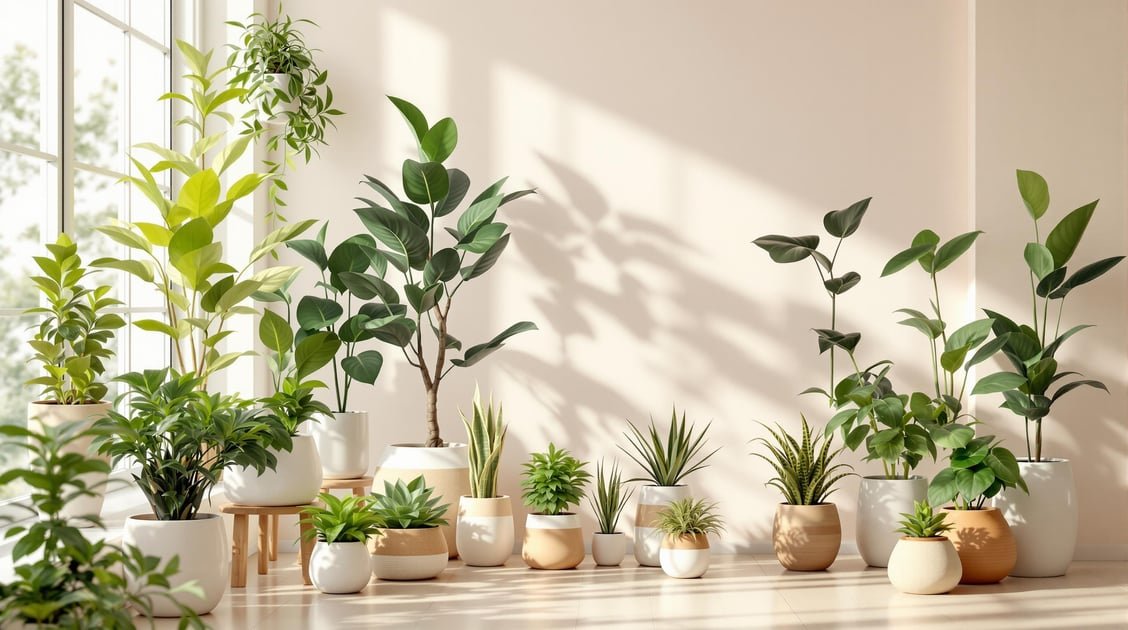
If you're short on time but still want greenery in your home or garden, these 15 low-maintenance plants are perfect for you. They require minimal care, thrive in various conditions, and are great for beginners or those with busy schedules.
Top Picks:
- Snake Plant: Tolerates low light, infrequent watering, and thrives indoors.
- ZZ Plant: Virtually indestructible, grows well in low light, and needs minimal watering.
- Pothos: Adaptable to light conditions, easy to grow, and purifies air.
- Spider Plant: Hardy, grows in indirect light, and produces baby plants (spiderettes).
- Chinese Evergreen: Thrives in low light, drought-tolerant, and long-lasting.
- Lavender: Drought-resistant, fragrant, and thrives in sunny outdoor spots.
- Sedum (Stonecrop): Hardy succulent that thrives in poor soil and full sun.
- Hostas: Perfect for shady areas, requires little watering once established.
- Daylilies: Reliable blooms, drought-tolerant, and low-maintenance.
- Boxwood: Evergreen shrub that maintains its shape naturally with minimal pruning.
- Russian Sage: Drought-resistant, pest-free, and attracts pollinators.
- Coneflower: Bright, long-lasting blooms that thrive in poor soil and full sun.
- Black-Eyed Susan: Vibrant flowers, drought-tolerant, and supports wildlife.
- Coral Bells: Colorful foliage for shaded areas, easy to care for.
- Ferns: Lush greenery perfect for shaded spots indoors or outdoors.
Quick Comparison Table:
| Plant | Light Needs | Watering Frequency | Key Features |
|---|---|---|---|
| Snake Plant | Low to bright | Every 2 weeks | Hardy, air-purifying |
| ZZ Plant | Low to bright | Every 3-4 weeks | Durable, low light tolerant |
| Pothos | Low to bright | Every 1-2 weeks | Air-purifying, fast-growing |
| Spider Plant | Indirect light | When topsoil is dry | Produces baby plants |
| Chinese Evergreen | Low to bright | Every 1-2 weeks | Long-lasting, drought-tolerant |
| Lavender | Full sun | Deep, infrequent | Fragrant, drought-resistant |
| Sedum | Full sun | Rarely | Hardy succulent |
| Hostas | Shade | Weekly | Foliage for shady areas |
| Daylilies | Full sun | Weekly | Reliable blooms |
| Boxwood | Sun to shade | When dry | Evergreen, minimal pruning |
| Russian Sage | Full sun | Rarely | Drought-resistant, pollinator-friendly |
| Coneflower | Full sun | Rarely | Bright blooms, wildlife-friendly |
| Black-Eyed Susan | Full sun | Rarely | Vibrant flowers, low-maintenance |
| Coral Bells | Shade | When dry | Colorful foliage |
| Ferns | Shade | Weekly | Lush greenery |
These plants are perfect for anyone who wants a beautiful, green space without the hassle. Whether indoors or outdoors, there's a low-maintenance plant for every space and lifestyle.
Top 12 Zero or Low Maintenance Plants for Lazy Gardeners

1. Snake Plant (Sansevieria)
The Snake Plant is a hardy succulent with tall, sword-shaped leaves, and some can live for over 20 years with minimal attention.
This plant tolerates a range of lighting conditions, from dim spaces to bright, indirect light. However, it thrives best in bright, indirect light - direct sunlight can scorch its leaves. Its resilience makes it an easy choice for plant enthusiasts.
"When sansevierias started their steady climb in the popularity polls, new varieties started emerging. As for care, they are all bulletproof."
– Tovah Martin, Author of The Indestructible Houseplant
Care Tips
- Watering: Let the top 2 inches of soil dry out before watering. This usually means watering every two weeks during the growing season and even less in winter. Overwatering can cause root rot.
- Temperature: Keep it in temperatures above 50°F (10°C).
- Soil: Use a well-draining potting mix.
Long-Term Care
Dust the leaves occasionally with a damp cloth to keep them clean. Repot every 3–5 years when the roots outgrow the pot, and fertilize monthly during spring and summer to encourage growth. With over 70 species to choose from, there’s one to suit nearly any décor. Its low-maintenance nature makes it perfect for busy lifestyles or frequent travelers.
2. ZZ Plant (Zamioculcas zamiifolia)
If you're looking for a plant that thrives with little effort, the ZZ Plant is a fantastic choice. Known for its glossy, dark green leaves, this plant can handle tough conditions while still looking great.
"If ever there was the perfect plant for the ultimate brown thumb, the easy ZZ plant is it. This virtually indestructible houseplant can take months and months of neglect and low light and still look amazing." - Heather Rhoades, Founder of Gardening Know How
Here’s a closer look at its light and care needs.
Light Requirements
The ZZ Plant is incredibly flexible when it comes to light. Although it prefers bright, indirect light, it can also grow in very dim spaces. It's perfect for spots like windowless offices, bathrooms with little natural light, north- or east-facing windows, or areas lit by artificial light.
Water and Care
This plant doesn’t need frequent watering, making it ideal for those with busy schedules or forgetful habits.
| Lighting Condition | Watering Frequency | Notes |
|---|---|---|
| Bright, indirect light | Every 2-3 weeks | Let the soil dry out completely |
| Low light | Every 3-4 weeks | Water less often in winter |
| Artificial light | Every 2-3 weeks | Check soil moisture regularly |
Temperature and Environment
The ZZ Plant does well in typical indoor temperatures ranging from 60-75°F (15-24°C).
Maintenance Tips
- Fertilize once or twice a year during the growing season.
- Occasionally wipe the leaves with a damp cloth to remove dust.
- Avoid direct sunlight, as it can scorch the leaves.
With its resistance to pests and low-maintenance nature, the ZZ Plant is a great option for anyone who wants greenery without the hassle.
🚀 Ready to Reinvent Your Garden?
Join thousands of homeowners who have transformed their gardens using our AI design tool. Upload one photo to explore endless possibilities.
Get your AI garden designs →3. Pothos (Epipremnum aureum)
Pothos, also known as Devil's Ivy, is an easy-to-care-for plant that fits perfectly into busy lifestyles. Its cascading vines and shiny leaves effortlessly enhance any indoor space without demanding much attention.
"Pothos is an excellent indoor plant for beginners and experienced houseplant enthusiasts alike. It doesn't need a lot of light, is resistant to most common pests and diseases, and can be grown in a range of conditions with success." - Marie Iannotti, Life-long gardener and a veteran Master Gardener
Light and Location
Pothos adapts well to various lighting setups, making it a flexible choice for different environments:
- A few feet from east- or west-facing windows
- Near windows with sheer curtains
- Offices with artificial lighting
- Rooms with limited natural light
Water and Care Requirements
| Growing Condition | Watering Frequency | Care Tips |
|---|---|---|
| Bright, indirect light | Every 7-14 days | Check the top 2 inches of soil for dryness |
| Low light | Every 14-21 days | Water less during winter |
| Room temperature (65-75°F) | Adjust based on soil dryness | Look out for drooping leaves as a sign to water |
These simple care steps help the plant grow strong and healthy.
Growth and Maintenance
When given proper care, Pothos can grow 12–18 inches each month. To keep your plant thriving:
- Use a well-draining potting mix
- Keep temperatures above 50°F, ideally between 65-75°F
- Fertilize monthly during spring and summer with a balanced houseplant fertilizer
- Rotate the plant occasionally to ensure even growth
- Prune as needed to promote a bushier appearance
Special Features
Pothos is known for its air-purifying qualities, as confirmed by NASA research. Indoors, its vines can reach lengths of 6-8 feet (180-240 cm), making it a fantastic choice for hanging baskets, shelves, or trellises.
Important Note: Pothos is toxic if ingested by humans and pets, including cats, dogs, and horses. Keep it in a safe spot, out of reach of children and animals.
4. Spider Plant (Chlorophytum comosum)
The Spider Plant is a popular choice for its striking appearance and low-maintenance nature. Its long, arching leaves and dangling plantlets make it a visually appealing addition to any space.
Light and Growing Conditions
Spider Plants do best in bright, indirect light but can adapt to a range of lighting conditions. Position them near a window with filtered light, as direct sunlight may scorch their leaves. In dimmer light, their growth slows, and variegated varieties might lose some of their distinctive striping. Adjust your watering schedule based on the plant's light exposure.
| Light Condition | Growth Rate | Result |
|---|---|---|
| Bright, indirect | Fast growth | Produces many spiderettes, vibrant colors |
| Medium light | Moderate growth | Fewer spiderettes |
| Low light | Slow growth | Minimal spiderettes, reduced variegation |
Watering
Water the plant when the top inch of soil feels dry to the touch.
"Spider plants are easy to propagate through their spiderettes. Simply cut a healthy spiderette from the mother plant and place it in a container of water or directly into moist soil. Roots should start to form within a few weeks."
Propagation and Growth
Spider Plants are known for their simple propagation process. The plant naturally produces long stems, or stolons, with baby plants (spiderettes) at their ends. To propagate, place a spiderette in water until roots grow to 1–2 inches, or plant it directly in moist soil while it’s still attached to the mother plant.
Benefits
Spider Plants are more than just decorative. NASA research highlights their ability to purify indoor air. They’re also non-toxic to pets and humans, making them a safe choice for households with kids or furry friends.
Maintenance Tips
- Repot every 2–3 years when the plant outgrows its pot.
- Trim away any brown or yellowing leaves to keep it looking fresh.
5. Chinese Evergreen (Aglaonema)
The Chinese Evergreen is a fantastic choice for those with busy schedules. Its striking leaves and ability to thrive in different indoor conditions make it a favorite for homes and offices, even those with just fluorescent lighting. Just ensure temperatures stay above 60°F (15.5°C), as this plant doesn't handle cold well.
Light and Growing Conditions
This tropical plant is incredibly versatile when it comes to light. It grows well in both low-light and bright, indirect light settings, making it suitable for almost any room in your home or office.
Watering Schedule
Chinese Evergreens are quite forgiving when it comes to watering. They can handle periods of drought, so avoid overwatering them. DJ Freedem, founder of the Underground Plant Trade, says:
"Because this plant doesn't require a lot of light, it doesn't require constant watering".
Seasonal Care Guide
- Summer: Water every 7–10 days.
- Winter: Water about every two weeks or when the top half of the soil feels dry.
Popular Varieties
Here are some standout options for their beauty and durability:
- 'Silver Queen': Recognized for its silvery-green leaves.
- 'Maria' (Emerald Beauty): A compact, bushy variety.
- 'King Red': Excellent for low-light spaces.
- 'Silver Bay': Known for its upright, architectural leaves.
Sandra Mejia, founder of The Plant Chica, emphasizes their ease of care:
"They are great first plants because they are really low-maintenance and hard to kill".
Troubleshooting
Watch for these common signs:
- Drooping leaves with wet soil: This usually points to overwatering.
- Upright leaves with dry soil: Time to water.
With the right care, Chinese Evergreens can live for a decade or even longer. Just be aware that they are toxic to pets, so keep them out of reach.
6. Lavender (Lavandula)
Lavender is a great choice for homeowners who want a low-maintenance plant that brings both beauty and fragrance to their garden. This aromatic herb doesn’t demand much attention, making it a perfect addition for busy lifestyles.
Light and Growing Requirements
Lavender thrives in full sun, needing 6–8 hours of direct sunlight daily. In particularly hot regions, providing partial shade during the afternoon can help prevent overheating.
Soil and Planting Tips
Native to the Mediterranean, lavender does best in poor, well-draining soil and doesn’t require fertilizer. Use slightly alkaline soil and space plants 12–18 inches apart to promote airflow. To improve drainage, consider raised planting beds or mix in sand or limestone.
Watering Schedule
Lavender’s ability to tolerate drought is one of its standout features. Once established, it only needs occasional deep watering. Amy Andrychowicz, Founder and Owner of Get Busy Gardening, puts it simply:
"Taking care of lavender plants is pretty darn easy, and they require very little maintenance."
Adjust your care routine slightly depending on the season for the best results.
Seasonal Care Guide
| Season | Care Recommendations |
|---|---|
| Spring | Light pruning before new growth |
| Summer | Deep but infrequent watering |
| Fall | Light pruning after blooming |
| Winter | Little to no watering needed |
Natural Pest Resistance
Lavender naturally keeps pests at bay. It’s known to repel deer, rabbits, and many common garden insects.
Maintenance Tips
Lavender is one of those plants that thrives with minimal effort. Here are a few tips to keep it healthy:
- Plant in spring or early fall when the soil is warm.
- Prioritize excellent drainage to avoid root rot.
- Add a light layer of mulch, but keep it away from the base of the plant.
- Prune in early spring to encourage growth and again after blooming to maintain its shape.
Lavender grows well in USDA hardiness zones 4–10, depending on the variety, making it suitable for gardens across much of the United States. Its ease of care and delightful aroma make it a fantastic option for anyone looking to enhance their outdoor space with minimal effort.
🎨 Visualize Your Dream Garden Today!
Transform any outdoor space into a professional landscape design in minutes. Just upload a photo, choose your style, and let our AI do the rest.
Start your garden transformation now →7. Sedum (Stonecrop)
Sedum, commonly known as stonecrop, is a hardy succulent with thick leaves that store water, making it a great choice for those who prefer low-maintenance plants. It thrives in well-drained, nutrient-poor soil, which helps prevent it from becoming overly leggy.
Growing Requirements
Sedum is quite straightforward to grow. It needs at least six hours of direct sunlight each day, though some types can handle partial shade. Well-draining soil is essential, as overly fertile soil can hinder its growth.
"Stonecrops are perfect for gardeners of all skill levels since it requires very little care once established."
Watering Schedule
Once established, sedum requires very little water. Here's a seasonal watering guide:
| Season | Established Plants | Container Plants |
|---|---|---|
| Summer | Every 7–10 days | Check weekly |
| Fall/Winter | Every 2–3 weeks | Check bi-weekly |
| Spring | When the top inch is dry | Check weekly |
Maintenance Benefits
Sedum offers numerous benefits for gardeners, including:
- No deadheading required
- Year-round visual interest, even in winter
- Naturally resistant to deer and rabbits
- Attracts pollinators like bees and butterflies
- Performs well in USDA zones 3–9
Simple Care Tips
For best results, plant sedum in spring, spacing plants 6 inches to 2 feet apart depending on the variety.
"Sedums have it all! This perennial plant has succulent green foliage and produces clusters of star-shaped flowers that bloom from midsummer to fall. It's easy to care for and beloved by pollinators, too!"
The most important tip for growing sedum is to avoid overwatering. Experts emphasize, "An overwatered sedum will die a lot faster than an underwatered one." For a fuller, tidier appearance, pinch back taller stems in early summer to encourage bushier growth.
8. Hostas
Hostas are an easy-to-grow perennial known for their eye-catching foliage and reliable performance. They thrive in shady areas, making them a great choice for spots where other plants might struggle.
Growing Requirements
Hostas grow best in partial to full shade. Most varieties spread 1–3 feet wide and prefer well-draining soil enriched with organic matter.
"Hostas, with a palette of so many different colors, textures, and sizes have tremendous landscape value and offer great interest to the garden...Their lush green foliage, varying leaf shape, size, and texture, and their easy care requirements make them perfect for this area." - Martha Stewart
Seasonal Care Guide
| Season | Maintenance Tasks | Watering Needs |
|---|---|---|
| Spring | Add slow-release fertilizer, clear winter debris | Once a week |
| Summer | Remove spent flower stalks | Twice a week during dry periods |
| Fall | Tidy up damaged leaves | Water only as needed |
| Winter | Cut plants back to the ground | Minimal to no watering |
Growth Timeline
The time it takes for hostas to mature depends on the variety. Smaller, faster-growing types typically mature in 3-5 years, while larger ones may need 5-7 years to reach their full size.
Key Maintenance Benefits
- Handles Dry Spells: Once established, they can tolerate mild drought conditions.
- Low Maintenance: Rarely need dividing, making care straightforward.
- Seasonal Appeal: Their foliage stays attractive throughout the growing season.
- Cold-Hardy: Suitable for USDA zones 3 to 9.
These features make hostas a practical and visually appealing addition to many gardens.
Care Tips Made Simple
Water deeply but less often, focusing on soaking the root zone. Add a 2-inch mulch layer around the plants, keeping it away from the crown to avoid rot. Use a balanced, slow-release fertilizer in spring as new growth appears.
For regular upkeep, remove yellowing leaves and cut the plant back by early winter. These simple steps help prevent pests and promote healthy regrowth in spring.
sbb-itb-4d6a8dd
9. Daylilies (Hemerocallis)
Daylilies are a fantastic choice for gardeners seeking beautiful blooms without a lot of work. Known for their reliability, these perennials are a favorite among those with busy schedules.
Growing Requirements
Daylilies flourish in full sun (at least 6 hours daily) and prefer well-drained, fertile soil. Their adaptability makes them suitable for a wide range of garden settings, from borders to containers.
| Growing Condition | Requirement |
|---|---|
| USDA Zones | 3 to 9 |
| Sunlight | Full sun to light shade |
| Soil pH | 6.0 to 6.5 (slightly acidic) |
| Spacing | 18 to 24 inches apart |
| Planting Depth | Crown 1 inch below soil surface |
Why They're So Easy to Grow
Daylilies are almost foolproof. They rarely face issues with pests or diseases and can handle both drought and flooding conditions. Their dependable blooming habit makes them perfect for gardeners who want vibrant flowers without constant upkeep.
"If there's a 'sure bet' perennial, it must be the daylily." - Kathy LaLiberte, Gardener's Supply
Blooming Characteristics
Daylilies are known for their continuous display of color. While each flower only lasts a single day, mature plants produce multiple scapes, each carrying 12 to 15 buds. This staggered blooming creates the effect of uninterrupted color throughout the growing season.
Easy Care Tips
Watering:
- New plants: Water weekly until established
- Established plants: About 1 inch of water per week, often covered by rainfall
- Drought periods: Additional watering can encourage more blooms
Seasonal Care:
- Spring: Remove dead foliage and add compost
- Summer: Deadhead flowers if desired for prolonged blooming
- Fall: Clear away spent foliage
- Winter: No care needed
These simple practices, combined with their resilience, make daylilies a reliable choice for gardeners of all skill levels.
Adaptability to Different Climates
Daylilies adjust well to a range of climates. Evergreen varieties thrive in hot regions with mild winters, while dormant types are better suited for colder areas. Their ability to withstand both freezing winters and scorching summers ensures they perform well in a variety of growing conditions.
10. Boxwood (Buxus)
Boxwood shrubs bring reliable greenery to your garden all year long with minimal effort. Their evergreen nature and low-maintenance needs make them a popular choice for many landscapes.
Growing Requirements
Boxwoods thrive under the following conditions:
| Condition | Requirement |
|---|---|
| Light | Full sun to partial shade |
| Soil | Well-draining, evenly moist |
| Planting Depth | Root ball slightly above soil (1/8 inch) |
| Mulch Layer | 2-3 inches deep |
| Height/Width | 3-4 feet (varies by variety) |
Natural Shape Retention
Modern boxwood varieties are designed to maintain a tidy, compact shape naturally. This reduces the need for frequent pruning and makes them easier to care for overall.
"Many of today's boxwood plants have been bred to be compact, so they don't need a lot of pruning. They're often healthier, too, than heavily pruned older types."
Simple Maintenance Tips
Proper care involves occasional pruning and watering:
Pruning Tips:
- Prune in late winter or early spring for best results.
- Avoid pruning after August 1 to prevent cold damage.
- Thin branches instead of shearing for a natural look.
- Remove no more than one-third of the plant each year.
- Water deeply when the top soil feels dry or crumbly.
- Increase watering before frost to prepare for winter.
- Use mulch to help retain soil moisture.
Preparing for Winter
Boxwoods are hardy but benefit from protection against harsh winds and strong afternoon sun during winter. Ensuring they’re in a sheltered spot can help reduce stress and keep maintenance to a minimum.
Versatile Design Options
Boxwoods fit seamlessly into a variety of landscape designs:
- Formal hedges
- Foundation plantings
- Containers
- Garden borders
- Accent pieces
"Boxwood is beloved for its versatility in the landscape." - Kim Toscano
When choosing a variety, consider its mature size to avoid excessive pruning and ensure your garden remains both elegant and easy to maintain.
🌺 Professional Garden Design in Minutes!
Stop wondering what your garden could look like. Upload a photo and let our AI show you 50+ professional design possibilities instantly.
Transform your garden now →11. Russian Sage (Perovskia atriplicifolia)
Russian sage is a hardy perennial with striking silvery leaves and lavender-blue flower spikes that bloom from mid-summer through fall. It's perfect for gardeners who want a beautiful yet low-effort plant.
Growing Requirements
| Condition | Requirement |
|---|---|
| Light | Full sun |
| Soil Type | Well-draining, average to lean |
| Height | 3-4 feet |
| USDA Zones | 4-9 |
| Maintenance | Minimal |
A Carefree Addition to Your Garden
"Russian sage is ideal for lazy gardeners: plant it in full sun with well-drained soil and enjoy its beauty for months"
This plant is perfect for those who want long-lasting beauty without constant upkeep. Just follow a few simple steps to get it started.
Establishment Tips
- Choose a sunny spot with excellent drainage.
- Water consistently during the first growing season to help the roots settle.
- In early spring, cut back woody stems to about 6 inches to promote fresh growth.
Built-in Toughness
Russian sage is packed with features that make it a breeze to care for:
- Drought Tolerance: Once established, you'll rarely need to water it.
- Pest Resistance: Naturally keeps deer and most pests at bay.
- Disease Resistance: Stays healthy with little risk of common garden diseases.
- Thrives in Lean Soil: No need for extra fertilizer - it does well in poor soil.
Welcoming Pollinators
Beyond being easy to care for, Russian sage is a magnet for beneficial visitors like bees, butterflies, and hummingbirds, adding life and movement to your garden.
Maintenance Tips
To ensure your Russian sage stays lush and vibrant:
- Skip overwatering once the plant is established.
- Avoid heavy fertilization, which can make the plant floppy and reduce blooms.
- Opt for compact cultivars if you prefer varieties that don't require staking.
Russian sage is a stunning, no-fuss plant that brings beauty and pollinators to your garden while demanding very little in return.
12. Coneflower (Echinacea)
Coneflowers are a fantastic choice for homeowners seeking colorful blooms without the hassle. Native to North America, these plants are known for their durability and ability to thrive in less-than-ideal conditions.
Growing Requirements
| Condition | Requirement |
|---|---|
| Light | Full sun (6–8 hours daily) |
| Soil Type | Well-draining, average to poor |
| USDA Zones | 3–10 |
| Water Needs | Low once established |
These plants thrive in a variety of environments, making them a reliable option for gardeners.
Natural Resilience
Coneflowers are tough plants that can handle a range of challenges:
"Tough as nails, Coneflowers (Echinacea) are wonderful additions to the landscape with their brightly colored blossoms to be enjoyed over a long flowering season."
They are particularly resilient against:
- Drought
- Poor soil
- Heat and humidity
- Deer browsing
- Harsh weather conditions
This hardiness makes them an easy option for gardeners of all experience levels.
Care Instructions
To keep your coneflowers healthy, plant them in full sun with well-draining soil and follow these steps:
- First Growing Season: Water regularly to help roots establish.
- Once Established: Water only during prolonged dry spells.
- Use compost sparingly - excessively rich soil isn’t necessary.
- After the first frost, cut plants back to ground level.
Benefits for Your Garden
Coneflowers don’t just look great; they also bring added perks to your garden:
- Long blooming period from late spring to late summer.
- Attract butterflies, bees, and other pollinators.
- Perfect for cut flower arrangements.
- Ideal for prairie-style or naturalized garden designs.
Expert Insight
"Echinacea is an easy-to-grow perennial with long-lasting daisy-like flowers that attract beneficial pollinators and songbirds." – Janet Loughrey, Contributor, Proven Winners
For best results, space plants 18–24 inches apart and avoid overwatering to prevent root issues. Coneflowers are proof that low-maintenance plants can still deliver striking beauty to your garden.
13. Black-Eyed Susan (Rudbeckia)
Black-Eyed Susans bring bold, bright colors to your garden from early summer until the first frost. They’re perfect for homeowners looking for a vibrant, low-maintenance addition to their outdoor space. These flowers bloom reliably and require very little effort to keep them thriving.
Growing Requirements
| Condition | Requirement |
|---|---|
| Light | Full sun (partial shade tolerated) |
| Height | 24-36 inches |
| Soil Type | Average, well-draining |
| USDA Zones | 3-10 |
| Water Needs | Low once established |
Tough and Reliable
Black-Eyed Susans are known for their ability to adapt to a variety of conditions. Their fuzzy leaves make them less appealing to deer and rabbits, while their drought tolerance reduces the need for frequent watering. As Julie Martens Forney explains:
"Low-maintenance and lovely, black-eyed Susan flowers start opening in early summer and keep on coming until fall frost."
Easy Care Guidelines
These plants are incredibly easy to care for and require only a few simple steps to thrive.
Watering Tips
- Water regularly during the first few weeks to help roots establish. Once settled, they need minimal watering thanks to their drought tolerance.
Soil and Feeding
- They grow well in average soil with good drainage.
- Fertilizer isn’t necessary - just a light side dressing of compost will do.
Benefits for Wildlife
Black-Eyed Susans not only beautify your garden but also support local wildlife.
- They attract pollinators like bees and butterflies.
- When left standing, they add visual interest to your garden in winter.
- Their seeds provide food for birds during colder months.
Long-Term Care
Keep your Black-Eyed Susans healthy and vibrant with a few simple practices:
- Divide clumps every 4-5 years to control spreading.
- Deadhead flowers to encourage more blooms, though leaving some spent blooms can help with natural reseeding.
These cheerful flowers are a great choice for gardeners who want stunning results without a lot of work. They’re an excellent example of how a little effort can go a long way in creating a lively, colorful garden.
14. Coral Bells (Heuchera)
Coral Bells bring a splash of color and charm to shaded areas with their vibrant foliage and low-maintenance nature. These perennials are perfect for homeowners who want to brighten up their garden without too much effort.
Growing Requirements
| Condition | Requirement |
|---|---|
| Light | Partial to full shade |
| Soil pH | 6.0 to 7.0 |
| USDA Zones | 4-9 |
| Water Needs | Water regularly during the first year; after that, only when the top 2 inches of soil are dry |
Stunning Varieties for Shady Spots
Coral Bells come in a wide variety of colors, making them a great choice for adding visual interest to shady gardens. Some standout options include Proven Winners' "Blackberry Ice", which features reddish-purple leaves with bold black veining, and Terra Nova Nurseries' "Lime Marmalade", known for its bright, frilly leaves that brighten darker corners.
Like hostas and ferns, Coral Bells are an excellent addition to shaded gardens, offering beauty with very little upkeep.
"Coral bells, also called Heucheras, are evergreen or semi-evergreen shade-loving plants that open gorgeous clusters of blooms on tall stalks."
Easy Care Instructions
During the first year, water Coral Bells regularly to help them establish strong roots. After that, water only when the top 2 inches of soil feel dry. In spring, remove any damaged leaves. In summer, trim away spent blooms. For fall, add a layer of mulch to protect the roots from freeze-thaw cycles.
Tips for Long-Term Growth
Use organically rich, well-draining soil to plant Coral Bells. Place lighter-colored varieties in deeper shade to prevent fading and divide clumps every 3 to 4 years to keep them healthy. These perennials also pair well with other shade-loving plants, creating a garden that’s both beautiful and easy to maintain.
🚀 Ready to Reinvent Your Garden?
Join thousands of homeowners who have transformed their gardens using our AI design tool. Upload one photo to explore endless possibilities.
Get your AI garden designs →15. Ferns
Ferns are easy-to-care-for plants that add a lush, tropical feel to any indoor or outdoor space. With the right setup, they require minimal effort to thrive, making them a great choice for plant lovers looking for beauty without too much work.
Low-Maintenance Varieties
| Fern Type | Key Features | Best Location |
|---|---|---|
| Boston Fern | Graceful arching fronds | Indoor hanging baskets |
| Kimberly Queen | Handles low humidity, rarely sheds | Indoor or sheltered outdoor |
| Blue Star Fern | Adapts to drier conditions, tolerates more light | Indoor bright spots |
| Lady Fern | Resists pests and diseases | Outdoor shade gardens |
| Hart's Tongue | Easy to care for, pest-free | Outdoor shaded areas |
Basic Care Requirements
Ferns do best in temperatures between 65–75°F (18.3–24°C) with consistent moisture. They thrive in bright, indirect light and need proper humidity to stay healthy.
"Boston ferns are relatively easy to grow as long as you stay on top of three things - moisture, sunlight, and temperature control." - Hollyanna McCollom, Better Homes & Gardens
Simple Maintenance Tips
To keep your ferns looking their best:
- Watering: Check soil moisture often and water once or twice a week when the surface feels dry.
- Light: Place ferns in bright, indirect light. Indoors, north-facing windows or filtered eastern exposure work well. Outdoors, keep them shielded from direct sunlight.
- Humidity: Increase humidity by using pebble trays with water under the pots, grouping plants together, or running a humidifier nearby.
- Fertilizing: Feed with a diluted liquid houseplant fertilizer during spring or when leaves start yellowing. Skip feeding during fall and winter.
Historical Interest
The Boston fern has an interesting backstory. It was first discovered in 1894, arriving in Boston as part of a shipment from Philadelphia. Another variety, the 'Dallas' fern, is a great option for those with less time to care for plants, as it tolerates lower light and drier air better than the traditional Boston fern.
Basic Plant Care Guide
Caring for plants becomes easy with a few simple practices tailored to their needs.
Smart Watering Practices
Before watering, check the soil by inserting your finger about 2 inches deep to gauge dryness.
| Season | Watering Frequency | Tips |
|---|---|---|
| Spring/Summer | More frequent | Check soil every 2–3 days |
| Fall/Winter | Reduced | Check soil weekly |
| High Humidity | Less frequent | Watch for browning leaf tips |
| Hot Weather | More frequent | Water in the early morning or evening |
Simplified Soil Care
Follow these steps to keep your soil in great condition:
- Use a well-draining potting mix for container plants.
- Add a 2- to 3-inch layer of mulch to help retain moisture.
- Ensure pots have proper drainage holes to prevent waterlogging.
- Water deeply but less often to encourage strong root growth.
Good soil care reduces the need for frequent watering and supports healthy plant growth.
Pruning Basics
"Tip-pruning encourages more shoots to grow from every cut point, which leads to an even, rounded, bushy plant and more flowering stems." – Homes to Love
- Use sharp, disinfected tools to make clean cuts just above leaf nodes.
- Remove dead or damaged growth as soon as you notice it.
- Avoid pruning more than 25% of the plant at one time.
- Water thoroughly after pruning to help the plant recover.
Temperature and Light
Maintaining the right environment is crucial for healthy plants. Keep temperatures between 65–75°F (18.3–24°C) and provide bright, indirect light. Rotate plants regularly for even growth. During summer, move them away from south-facing windows to protect leaves from burning.
Additional Care Tips
For extra care, try these adjustments:
- Use distilled or filtered water for sensitive plants like Spider Plants and Peace Lilies.
- Group plants together to create a humid microclimate.
- Yellowing leaves often mean overwatering, while brown edges suggest underwatering.
- Pay attention to leaf color and adjust care as needed.
Conclusion
Low-maintenance plants provide a great way for busy homeowners to enjoy greenery without the hassle of intensive upkeep. Beyond their visual appeal, these plants can also help reduce stress and boost productivity, as highlighted in a 2019 study. This makes starting a plant collection both enjoyable and manageable.
For those new to houseplants, options like the Chinese evergreen and ZZ plant are excellent choices. These plants are known for their durability and minimal care needs, making them perfect for anyone with a packed schedule.
To get the most out of your low-maintenance plants, consider these tips:
- Pick plants with similar care needs to simplify your routine.
- Place plants where they’ll thrive based on their light and water preferences.
- Begin with one or two plants to ease into the process.
- Opt for varieties that require little pruning or upkeep.
Related posts
Related Articles

Checklist for Maintaining Garden Lighting Systems
Learn essential tips for maintaining your garden lighting system, ensuring safety and aesthetics throughout the seasons.
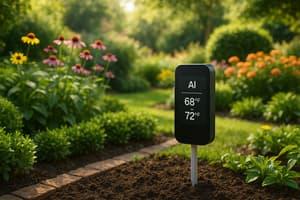
How AI Regulates Garden Temperatures Automatically
AI systems automate garden temperature control, ensuring optimal conditions for plants while conserving energy and resources.
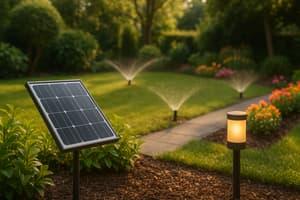
Ultimate Guide to Solar IoT Garden Automation
Explore how solar-powered IoT systems transform gardening with automation for watering, lighting, and plant health monitoring.
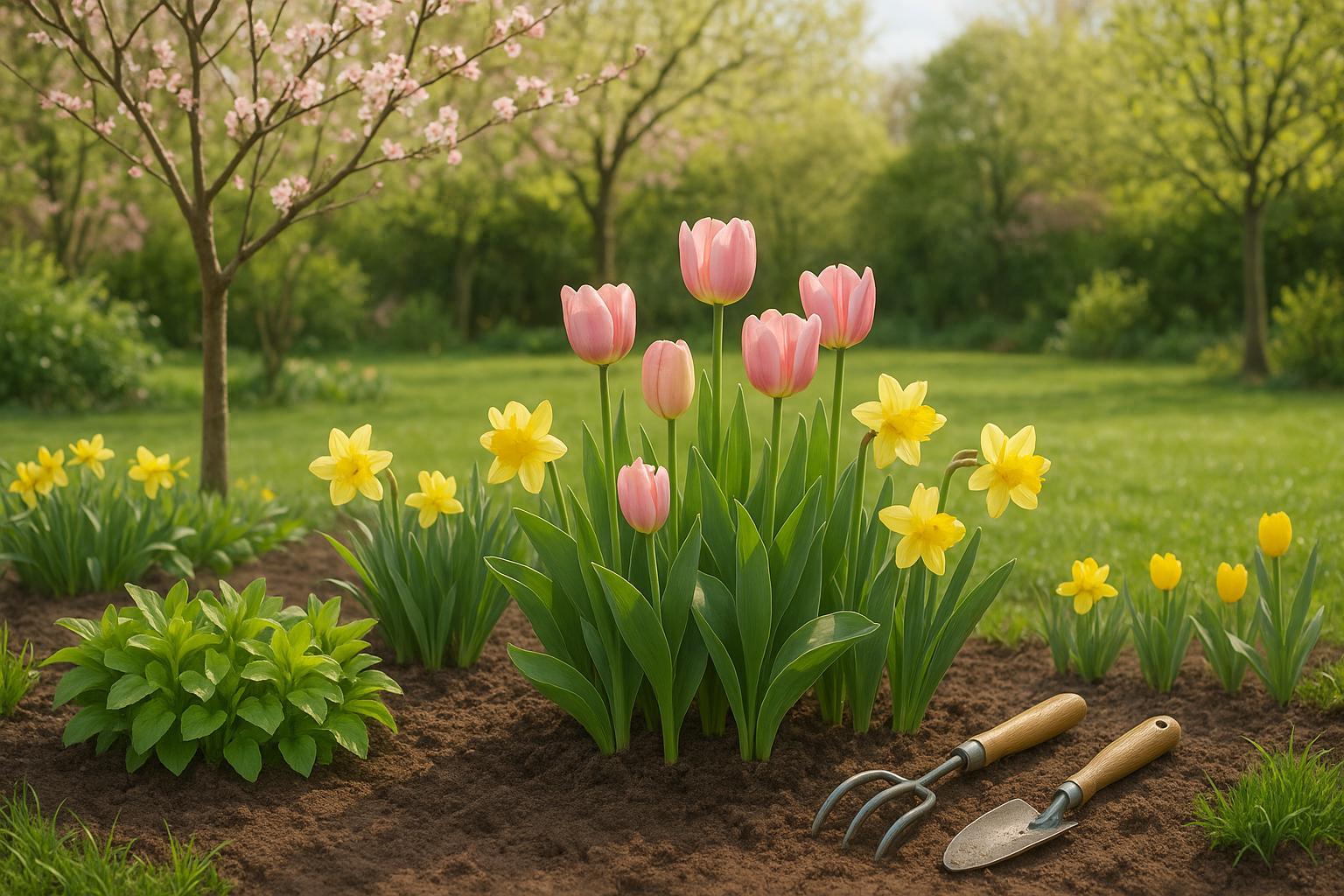
Ultimate Guide to Seasonal Plant Selection
Learn how to select seasonal plants for your garden based on climate, soil, and light conditions with AI tools for tailored recommendations.

Choosing the Best Garden Layout: Factors to Consider and Popular Options
Create a beautiful and functional garden with the best layout that suits your space, soil quality, climate, and personal preferences. Learn about popular garden layouts like raised bed, square foot, container, and traditional row garden layouts.
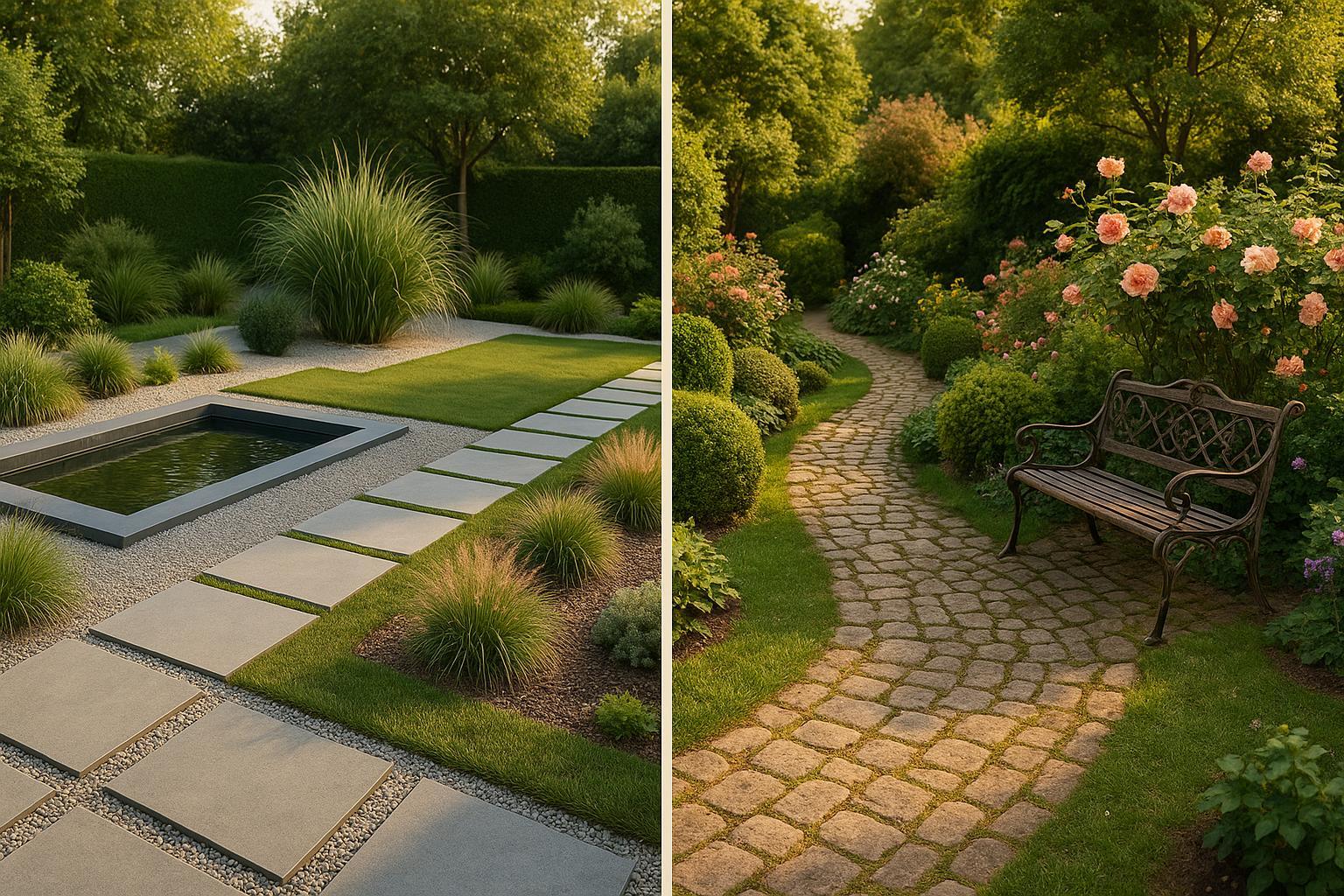
Modern vs. Classic Garden Themes: AI Design Tips
Explore the differences between modern and classic garden styles with AI design tools that simplify planning and plant selection.